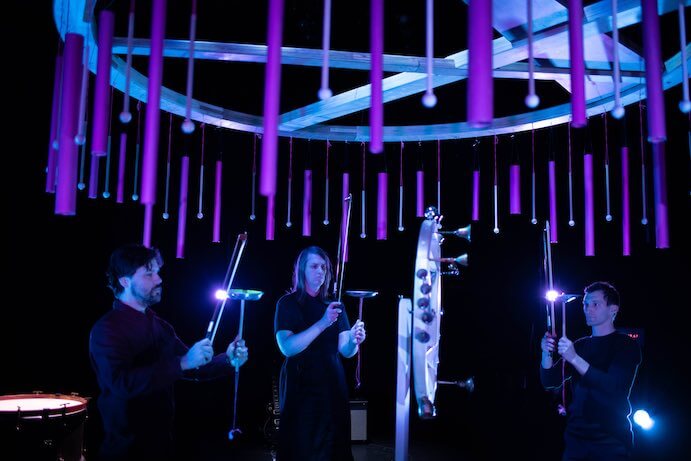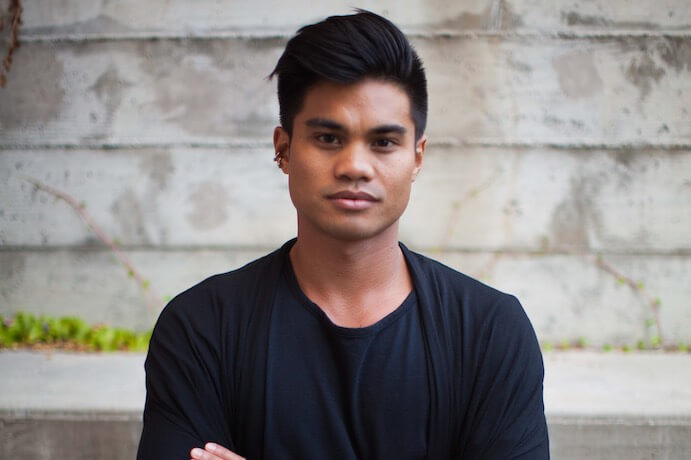“This feels so formal!” Amadeus Julian Regucera exclaims. We’re supposed to meet in a minimalist office with big windows, but the sun has set and the overhead lighting is unfriendly. “Hold on… let me see what I can do.” They run down the hall and rattle a few doors before throwing open the Conductor’s Suite, four times the size of the office with warm lamps and a big couch. “Aha! Let there be light.”
It’s a fitting introduction to Regucera. Throwing doors open is now their full-time job: in September 2022, they relocated from California to Troy, New York, to become the staff Music Curator for the Curtis R. Priem Experimental Media & Performing Arts Center (EMPAC). Regucera invites artists to EMPAC for residencies, curates programs of extant or evolving works, and offers another perspective to the artistic process.
“I’ve had conversations about developing projects here, and I keep telling composers, ‘Bigger!’ Or, if not bigger, imagine you can do anything.” That is unlike most artistic projects, Regucera concedes, which usually have technical, time, or budget restrictions, and it’s hard to avoid a scarcity mindset. “Here it’s kind of the opposite,” Regucera says. “This place is geared towards realizing artists’ most epic dreams, and getting artists to expand their thinking is part of my mission. Fill the space with your imagination, and then I’ll tell you when we can’t do something.”

EMPAC — which Regucera calls a unicorn or UFO — was the vision of Dr. Shirley Jackson, the former president of the Rensselaer Polytechnic Institute. Rensselaer emphasizes media and technology over traditional humanities courses, and Jackson wanted to enhance the university with a hub for artistic R&D that mirrored the other research labs on campus. It was a collaborative endeavor: the Chair of the Mechanical, Aerospace, and Nuclear Engineering Department led the EMPAC vision task force, and the Dean of the School of Architecture oversaw the international competition to select the architect for the building. To develop the center’s artistic program, Dr. Jackson recruited Johannes Goebel, the founder and head of the Institute for Music and Acoustics at ZKM, the Center for Art and Media Technology in Karlsruhe, Germany.
Goebel built EMPAC on a European research model, hiring full-time staff curators to guide the allocation of resources and cultivate artistic collaborations. The Center is experimental in the full sense of the word, functioning like scientific research where progress is slow, the process is prized, and failure is definitely an option. Despite all this, EMPAC’s distinctive resource is the expert technical staff that run its four performance venues. The recent Jan. 27 performance of Sarah Hennies’ A Kind of Ache featured a massive chandelier-like sculpture rigged to the ceiling that the performers played on, which Regucera regarded as “a simple thing for the staff.” On Feb. 25, they’ll fly a piano in the air for Mary Kouyoumdjian’s Paper Pianos, and this fall they’ll build a volcano that will float down the Hudson River.
The spotlight makes me feel anxious, but I love giving it to other people and providing the stage for people to do their thing.
Regucera is still coming to terms with their curatorial carte blanche. They completed a PhD in composition at UC Berkeley, lectured there as an adjunct professor, and composed several works that effectively expressed their creative intentions. But Regucera was also burned out, holding additional arts admin and production jobs to make ends meet. By the time their former UC Berkeley advisor recommended the EMPAC job posting, Regucera was open to the idea despite the stipulation that practicing artists would have to stop. “I really just kind of liked making stuff — making events happen, facilitating music, finding venues, talking with artists — and I like doing that for other people,” Regucera reflects. “The spotlight makes me feel anxious, but I love giving it to other people and providing the stage for people to do their thing.”
You might expect someone with 15 years in academia to have strictly defined aesthetic preferences. But if you ask Regucera about their curatorial methodology, they just laugh. “I do have highfalutin’ ideas about art, and I probably read too much for my own good,” they confess (with a cheerful digression into the pros and cons of disciplinary authority). “I’m starting with what I know and doing research. I have to look at my own tastes in a formal way and become more omnivorous in what I listen to. It’s about looking for potential development.” A big part of the job is researching new composers and music, which Regucera enjoys, even if the intellectual nature of the work can feel odd: although they often hear other curators and artists say that curiosity is a kind of driving force in discovery, for Regucera curiosity comes after being affected by an encounter with art.

That’s one of the reasons Regucera programmed A Kind of Ache as their inaugural music program. Featuring a playable sculpture by visual artist Terry Berlier and gorgeous interplay between the rotating sculpture and a walloping range of sonic textures, Sarah Hennies’ hour-long piece with The Living Earth Show spoke to Regucera first on an affectual level. “Instead of saying, ‘I want to program this piece because it’s formally this or that…’ the reason why I love A Kind of Ache is because it hits me. It’s sharing sad queer vibes and hoping that sort of sensation connects people… regardless of whether they’re queer or not.” Regucera hopes these genuine feelings spark connection and curiosity — and support the important dialogue of inclusivity without falling back on platitudes or boxing compositions into identity labels.
“I feel like there are some curators — and maybe more in the visual arts world — who go ‘This is what I like and I’m going to curate this,’” Regucera muses. “But for me coming into this situation, it was ‘I know what I like… but how can I expand that and be more open?’” They list a few characteristics of the ideal EMPAC musician: an artist who knows what they want, what they’re trying to get after, who is mid-career or at a turning point, and who needs a team to realize that one big idea. “I’m basically walking around with a toolbox,” says Regucera. “My job is just to find who needs the tools.”
I CARE IF YOU LISTEN is an editorially-independent program of the American Composers Forum, and is made possible thanks to generous donor and institutional support. Opinions expressed are solely those of the author and may not represent the views of ICIYL or ACF.
You can support the work of ICIYL with a tax-deductible gift to ACF. For more on ACF, visit the “At ACF” section or composersforum.org.
























